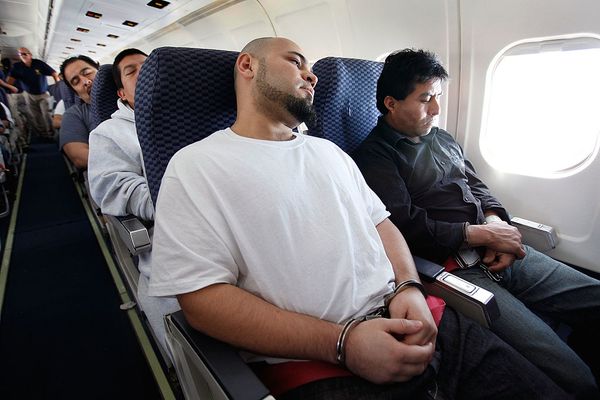Each film by Orson Welles feels like a first film, wrestled into shape by an artist working by instinct as well as craft. The two-hour version now available of Welles' last first film, "The Other Side of the Wind," exists as ... well, it exists, which is miracle enough.
Shot between 1970 and 1976, Welles spent a total of 14 thwarted years trying to finish the thing. The project grew out of an idea Welles had been mulling since the 1950s, about an Ernest Hemingway-like writer, drunk on his own machismo, chasing a bullfighter around Spain, while sycophants and admirers and biographers and human leeches chase after the writer. Two decades before that, when Welles was a rising radio star and about to become the man who made "Citizen Kane," he got into a brawl with Hemingway. They shook hands and laughed it off soon enough. But Welles squirreled the incident away for the winter of his career.
In story terms, not that they matter much, "The Other Side of the Wind" deals with a pretty simple hall-of-mirrors concept. We're with the moviemaking and literary guests at the desert home of famous, reclusive, cash-strapped film director Jake Hannaford, played by John Huston. It's his 70th birthday party. At the party, Hannaford is screening footage from his long-rumored comeback picture, "The Other Side of the Wind," Hannaford's attempt to "get with" the vibe and the spirit of New Hollywood.
From what we see, Hannaford's film is in the Michelangelo Antonioni "Zabriskie Point" vein, full of vast spaces between alienated, sullen, wandering lovers. The young man is played by a discovery of Hannaford's, though he is not who, or what, he seems, and has bolted the project, leaving Hannaford in the lurch. The young woman, constantly, constantly nude, is played by Oja Kodar, who was Welles' lover and the credited co-screenwriter. Kodar herself directed the movie's (and the movie-within-a-movie's) arresting sexual centerpiece, an encounter inside a car during a rainstorm without a speck of tenderness. Everything Hannaford touches, the scene implies, turns to matters of power and control and aggression.
Against his personal code of honor, Hannaford has it in mind to persuade his friend, acolyte and fellow director Brooks Otterlake (Peter Bogdanovich, more or less playing himself) to put up the completion money for his movie. Theirs is a friendship of mutual respect and mutual distrust. Impressionist Rich Little (seen briefly in the version of "Wind" we now have) started out playing Otterlake for Welles, but Bogdanovich, a former film-journalist-turned-New-Hollywood winner ("The Last Picture Show" came out in 1971), replaced him.
Hannaford's party devolves into a riot of images. Welles depicts the boozy, itchy revels, which eventually move from Hannaford's home to a drive-in movie theater, through a variety of viewfinders, as if "The Other Side of the Wind" were not a single "found" object, but a scrambled assemblage of all sorts of black-and-white and color footage documenting the birthday and its various mini-dramas.
Welles wanted to pull the rug out from under the town, and the industry, that enticed and then betrayed him. "The Other Side of the Wind" plays like Luigi Pirandello's "Six Characters in Search of an Author," only it's more like "Six Movies in Search of Their Maker." It's a film that refused to be completed about a film that refuses to be completed, featuring a cast of real-life emblems of Old Hollywood (George Jessel is in it, for one) in proximity to exemplars of New Hollywood (Dennis Hopper, hot off "Easy Rider" but cold off "The Last Movie," pops in to talk about how he'd like "John Wayne's audience to see my movie").
Had it been finished and released in the '70s, it would've flopped like "The Last Movie" flopped. This doesn't mean the Netflix-backed version of "The Other Side of the Wind," which streams starting Friday, is dismissible or uninteresting. (On 35 millimeter film, Welles' picture screens this weekend at the Music Box Theatre.) Assembled from 100 hours of footage only recently released from various circles of legal hell, the labor of tough love got the angels it needed in producers Frank Marshall and Filip Jan Rymsza, overseen by Bogdanovich.
Some elements are brand-new, such as the cocktail-jazzy Michel Legrand score. The nervous rhythm established by editor Bob Murawski, following the lead of the footage Welles himself assembled, keeps the film in constant state of agitation. Half the time, Welles punctures Hannaford's misogyny and bullying and desperation; the rest of the time, he's apologizing for it, or admiring it, because he recognizes it in his bones.
The movie's full of acidic wisecracks and zingers, though its attempts to be funny aren't really funny. I found Paul Stewart, who dates back to Welles' "Mercury Theater of the Air" days, to be the strongest human presence in this ghostly affair. As Hannaford's right-hand man and fixer, a piece of Old Hollywood, Stewart mutters, wittily, about this "bunch of creeps who only wanna listen to themselves talking."
There's a companion documentary, Morgan Neville's "They'll Love Me When I'm Dead," which charts the various stages of incompletion "The Other Side of the Wind" endured. Also available on Netflix starting Friday, this only adds to the hall-of-mirrors motif. Welles loved that image: Starting from his first feature, "Citizen Kane," and most famously in the literal hall-of-mirrors shoot-out in "The Lady From Shanghai," mulitple mirrored reflections of his protagonists filled the screen. The filmmaker loved that motif. "The Other Side of the Wind" seems to be taking place inside in one of those mirrors. It feels both quaintly modish and sincerely modern, a self-directed critique of Welles and of the industry built, as Hannaford says, on the idea of capturing "the great places and the pretty people." And then setting up the next shot.







